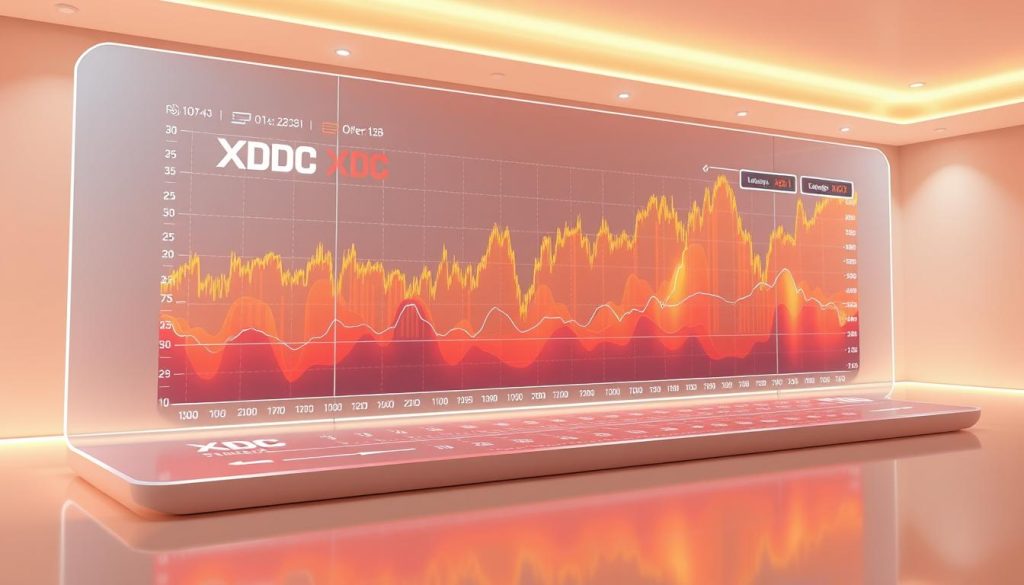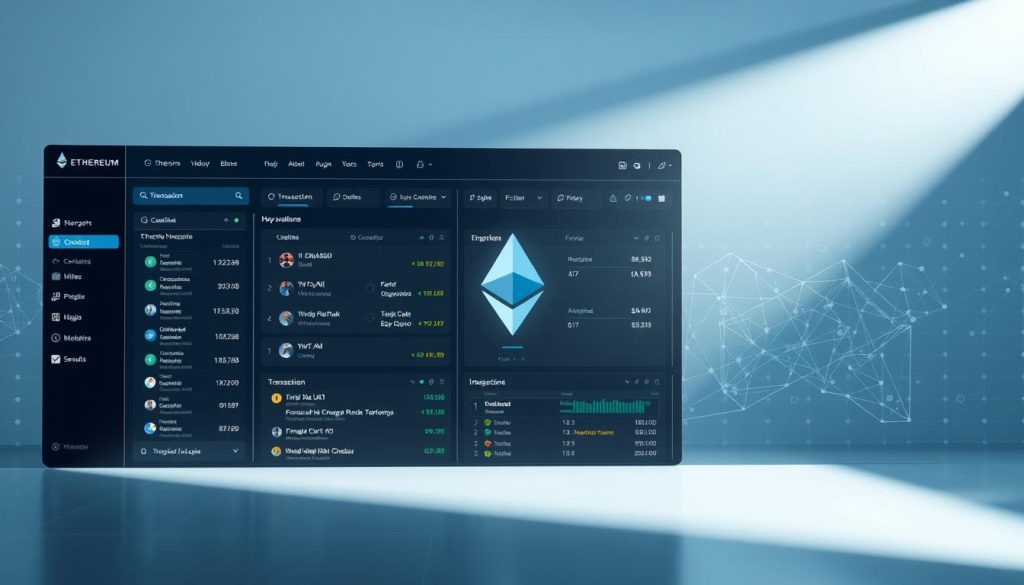Genesis Digital’s new facility in Texas uses more electricity than some small cities. Their achievement in Glasscock County is truly remarkable. This project showcases the future of industrial-scale crypto mining.
This isn’t just another data center with mining rigs. It’s the largest bitcoin mining farm Texas has ever seen. The scale of their operation is changing the game for crypto mining in America.
Genesis Digital’s success marks a turning point for bitcoin mining operations across the nation. Their facility’s stats are impressing experts throughout the cryptocurrency world. It shows what happens when big money meets big dreams in Texas.
Key Takeaways
- Genesis Digital operates the largest bitcoin mining facility in Texas, located in Glasscock County
- The facility consumes electricity comparable to small cities, showcasing industrial-scale crypto mining
- This operation represents a pivotal moment for bitcoin mining operations in America
- The project demonstrates how serious capital investment is reshaping cryptocurrency infrastructure
- Texas continues to emerge as a major hub for large-scale digital asset mining operations
Introduction to Bitcoin Mining
Bitcoin mining isn’t as complex as it seems. The basics are simple once explained without crypto jargon. It’s like a never-ending digital math contest.
Specialized computers worldwide race to solve puzzles. The first to crack the code wins Bitcoin. That’s the core idea behind mining.
What is Bitcoin Mining?
Bitcoin mining is a computational verification process that keeps the network running. Miners collect and group pending Bitcoin transactions. They compete to solve a cryptographic puzzle using massive computing power.
The winner adds their block to the blockchain. They receive newly created Bitcoin as payment. The network adjusts puzzle difficulty every two weeks.
Modern mining facilities are massive. Imagine warehouses full of specialized machines called ASICs. These purpose-built computers mine Bitcoin with incredible efficiency.
Importance of Mining in the Bitcoin Ecosystem
Mining is the backbone of the entire system. Without it, Bitcoin would be worthless digital money. Mining does more than create new coins.
It serves three critical functions:
- Network security: Every transaction gets verified and recorded permanently
- Decentralization: No single entity controls the network
- Monetary policy: New Bitcoin enters circulation at a predictable rate
Industrial miners secure billions in digital assets worldwide. They ensure transactions happen and can’t be faked. The system is trustless, needing no central authority.
These massive operations are crucial to global financial infrastructure. They maintain Bitcoin’s security, decentralization, and value. It’s a financial system independent of traditional banking.
Overview of Genesis Digital
Genesis Digital Assets stands out in the crypto world. They focus on building sustainable mining infrastructure. Their approach impresses with its emphasis on operational excellence rather than flashy marketing.
The company creates lasting value in a volatile industry. They’ve built their reputation on solid engineering principles. Their strategic partnerships make sense financially and environmentally.
Company Background
Genesis Digital Assets aims to build profitable Bitcoin mining operations. Their leadership combines expertise from energy sectors and technology development. They focus on large-scale deployment of high-performance mining rigs.
Their strategy goes beyond chasing the latest hardware trends. They carefully evaluate technology upgrades against long-term operational costs. The company has secured strategic partnerships with energy providers across Texas.
These relationships provide access to reliable power sources at competitive rates. This is crucial for large-scale mining operations.
We’re not just mining Bitcoin – we’re building the infrastructure that will support the network for decades to come.
Achievements and Milestones
Genesis Digital has a strong track record. They’ve deployed thousands of mining units across multiple facilities. Each facility is designed as an energy-efficient mining data center.
Here are their key accomplishments that caught my attention:
- Largest single mining facility in Texas, setting new industry standards for scale
- Strategic energy partnerships that provide stable, cost-effective power supply
- Regulatory compliance achievements that enable continued expansion
- Operational efficiency metrics that consistently outperform industry averages
Their ability to secure permits for large facilities is impressive. They’ve navigated the complex regulatory landscape for Bitcoin mining successfully. Their energy-efficient approach positions them well for future environmental regulations.
Genesis Digital anticipates policy changes and builds accordingly. Their expansion timeline shows careful planning rather than reckless growth. Each new facility improves on previous deployments.
This creates a sustainable model for growth in the competitive Bitcoin mining landscape.
The Largest Bitcoin Mining Farm Explained
The Genesis Digital mining farm in Texas is a technological marvel. It redefines Bitcoin mining possibilities. Its scale is so large that the numbers seem unreal.
This facility operates on an industrial scale beyond most people’s imagination. The engineering required for its efficient operation is mind-boggling.
Location and Infrastructure
Genesis Digital chose Glasscock County, Texas for its abundant and relatively cheap energy sources. Energy costs are critical for large-scale mining operations.
They’ve built a system designed for maximum efficiency and minimal downtime. The cooling systems are impressive, managing heat from 100,000 mining units.
Texas offers cheap electricity, favorable regulations, and robust power grid infrastructure. These factors make it valuable for strategic mining farm locations.
Mining Capacity and Technology
The facility operates at a 300MW capacity, enough to power a small city. At this scale, every efficiency percentage point matters tremendously.
The technology creates an optimized environment for peak equipment performance. Power distribution, cooling, and monitoring systems work together seamlessly.
This technological sophistication separates bitcoin hash rate leaders from smaller operations. It’s about having better systems for consistent performance.
Number of Bitcoin Miners Deployed
Genesis Digital has deployed about 100,000 mining units at this facility. That’s more mining power than entire countries had years ago.
Each unit represents cutting-edge ASIC technology designed for Bitcoin mining. Coordination keeps these machines running smoothly.
Their position among bitcoin hash rate leaders results from strategic planning and meticulous attention to operational details.
Statistics on Bitcoin Mining Farms
Bitcoin mining statistics reveal a transforming industry. It’s growing and reshaping around efficiency and sustainability. The global mining landscape has shifted dramatically over the past three years.
The U.S. now commands roughly 38% of the global hash rate. This shift has created new opportunities and challenges. Mining pool operators are still adapting to these changes.
Global Bitcoin Mining Trends
Current data shows fascinating patterns in Bitcoin mining’s global evolution. The hash rate distribution reveals the U.S. leads with 38%.
Kazakhstan follows at 13%, and Russia at 11%. Mining difficulty has increased by 45% over the past 12 months.
- Hash rate distribution: United States (38%), Kazakhstan (13%), Russia (11%)
- Energy consumption: Approximately 150 TWh annually worldwide
- Mining difficulty: Increased by 45% over the past 12 months
- Average mining farm size: 50-100 MW capacity for new installations
Mining pool operators have adapted to this geographic shift. They’ve rebuilt infrastructure networks and formed new partnerships across different regulatory environments.
Texas vs. Other States: A Comparative Analysis
Texas leads the U.S. mining race. The state accounts for about 14% of the global Bitcoin hash rate.
Here’s how Texas compares to other major mining states:
| State | Hash Rate Share | Primary Energy Source | Regulatory Environment |
|---|---|---|---|
| Texas | 14% | Natural Gas + Renewables | Deregulated Market |
| New York | 3% | Hydroelectric | Restrictive |
| Washington | 4% | Hydroelectric | Moderate |
| Wyoming | 2% | Coal + Wind | Crypto-Friendly |
Texas’s deregulated energy market offers unique advantages. It gives mining operations direct negotiation power with energy producers. This flexibility is crucial for large-scale operations.
Environmental Impact and Sustainability Practices
The environmental conversation around Bitcoin mining has progressed significantly. Current data shows 58% of Bitcoin mining uses renewable or sustainable energy sources.
Modern sustainable mining practices are becoming the industry standard. Leading facilities are implementing innovative solutions to reduce their environmental impact.
- Renewable energy integration (solar, wind, hydroelectric)
- Waste heat recovery systems for local heating
- Carbon offset programs and green energy certificates
- Advanced cooling systems that reduce energy consumption by 15-20%
Sustainable mining practices may soon become mandatory. Facilities that adopt these trends now will gain a significant competitive advantage.
Economic Impact of the Largest Bitcoin Mining Farm
Large-scale bitcoin mining operations reshape local economies. Genesis Digital’s Texas facility is a prime example. These installations become economic drivers for communities that struggle to attract major industrial investment.
The largest bitcoin mining farm creates an entire economic ecosystem. Its direct financial impact reaches millions of dollars annually. This comes through wages, local purchases, and tax contributions.
Job Creation in Texas
Genesis Digital’s facility offers impressive employment opportunities. These positions go beyond what people imagine for cryptocurrency mining.
Direct employment typically ranges from 50 to 200 full-time positions. These include tech jobs and other crucial roles.
Electrical technicians, facility maintenance crews, security personnel, and administrative staff keep operations running smoothly. Many positions offer salaries 20-30% above the local average. This wage premium creates a multiplier effect throughout the community.
Local Business Growth and Support
Indirect economic benefits often surpass direct employment impact. High-paying jobs create demand for housing, restaurants, and retail services.
Local contractors benefit from construction and maintenance contracts. Utility companies see revenue increases. The expanded tax base provides funding for schools, infrastructure, and public services.
Here’s what the economic impact typically looks like across different sectors:
| Economic Sector | Direct Impact | Indirect Benefits | Annual Value Range |
|---|---|---|---|
| Employment | 50-200 direct jobs | 150-400 indirect jobs | $15-45 million |
| Local Spending | Equipment & supplies | Employee purchases | $8-25 million |
| Tax Revenue | Property & business taxes | Income tax from workers | $3-12 million |
| Infrastructure | Utility upgrades | Road improvements | $5-15 million |
Communities hosting major bitcoin mining operations undergo remarkable transformations. Rural areas facing population decline attract new residents, businesses, and investment opportunities.
Cryptocurrency mining serves as a catalyst for broader economic development. It brings hope to regions that other industries have overlooked.
Predictions for Bitcoin Mining
Bitcoin mining’s future is shaped by three major forces. Technology is evolving faster than most realize. These changes will greatly impact mining operations and strategies.
Clear trends are reshaping the industry. Energy efficiency is becoming the ultimate differentiator. Successful facilities will maximize performance from every watt consumed.
Future Trends in Bitcoin Mining Technology
Next-gen mining hardware will be impressive. Prototypes are 30-40% more efficient than current models. Cryptocurrency mining facilities can expand without proportionally increasing energy use.
AI is playing a bigger role in mining. It predicts equipment failures and optimizes cooling. These systems time operations to benefit from fluctuating energy prices.
Facilities using these technologies see 15-20% efficiency improvements. This boost in efficiency is crucial for profitability.
Specialized hardware is becoming more advanced. We’re moving towards chips designed for Bitcoin’s SHA-256 algorithm. The industrial-scale bitcoin miners of tomorrow will be purpose-built machines.
Market Outlook for Bitcoin Mining in 2024
2024 will likely bring industry consolidation. Large-scale facilities will outcompete smaller, less efficient operations. The market is becoming harsh for inefficient operators.
Profitability will depend on three factors. These are cheap energy, efficient hardware, and sophisticated management systems.
Mining is shifting geographically. Industrial-scale bitcoin miners are moving to areas with renewable energy and favorable regulations. Texas, Wyoming, and parts of Canada are becoming mining hubs.
| Technology Factor | Current State | 2024 Prediction | Impact on Profitability |
|---|---|---|---|
| Hardware Efficiency | 95-110 J/TH | 65-80 J/TH | 25-35% cost reduction |
| AI Integration | Limited adoption | Widespread use | 15-20% efficiency gains |
| Renewable Energy | 35% of operations | 60% of operations | Long-term cost stability |
| Market Consolidation | Fragmented industry | Top 10 control 70% | Economies of scale |
Cryptocurrency mining facilities are becoming more like traditional industrial operations. They now use professional management and predictive maintenance. This maturation process benefits the entire industry.
The dominant facilities of 2024 are being built now. They apply industrial-grade engineering principles and lessons from early mining operations. This isn’t just about buying the latest miners anymore – it’s about building sustainable, efficient operations.
Tools and Technology for Mining
Professional mining facilities house millions of dollars worth of cutting-edge equipment. Today’s Bitcoin mining operations use advanced technology beyond powerful computers. It’s a complex system where every part matters.
Modern mining facilities are complete technological ecosystems. Each component plays a vital role in the process. From power input to Bitcoin verification, every piece must work perfectly.
Essential Equipment for Mining Operations
High-performance mining rigs are crucial for serious mining. ASIC miners can cost $3,000 to $12,000 each. They’re built to solve Bitcoin’s puzzles fast.
New ASIC miners offer hash rates over 100 TH/s. They use about 3,000 watts of power. This equals three household dryers running at once.
The heat from these machines needs advanced cooling. Energy-efficient mining data centers use industrial-grade cooling systems. These handle massive heat loads effectively.
Some facilities reach 85°F despite many cooling units. Cooling often uses 20-30% of total power. This makes efficiency key for profit.
Power infrastructure is also vital. Mining needs backup power and systems for megawatts of load. A single outage can cost thousands in lost revenue.
Mining Software and Management Tools
Mining software controls everything from miner performance to facility operations. It can track thousands of units at once. The software monitors chip temps, hash rates, and power use.
Management tools help optimize performance automatically. They adjust mining based on electricity prices. These tools can redirect hash power during network changes.
Remote monitoring allows control of multiple sites from one place. Some control rooms look like NASA mission control. They show real-time data from different locations.
| Equipment Category | Cost Range | Power Consumption | Lifespan |
|---|---|---|---|
| ASIC Miners | $3,000 – $12,000 | 2,500 – 3,500W | 3-5 years |
| Cooling Systems | $50,000 – $200,000 | 500 – 2,000W per unit | 10-15 years |
| Power Infrastructure | $100,000 – $500,000 | Variable | 20-30 years |
| Management Software | $5,000 – $25,000 | Minimal | 3-5 years |
All these parts create efficient mining centers that can profit in tough markets. Success isn’t just about speed. It’s about building a system where everything works well together.
Guide to Investing in Bitcoin Mining
Bitcoin mining investment can be rewarding but challenging. Proper preparation is crucial to avoid unexpected problems. Smart investing requires understanding both technical and financial aspects.
Success in mining investments needs thorough research and realistic expectations. You’re entering a competitive industry where margins can shift quickly. Market conditions play a big role in profitability.
Understanding the Financial Aspects
Master core financial metrics before investing. Hash rate, power consumption, and electricity costs are key to mining investment analysis.
When evaluating mining investments, I focus on these factors:
- Break-even calculations: Most profitable operations reach break-even within 12-18 months
- Electricity costs: Should be under $0.06 per kWh for competitive operations
- Network difficulty adjustments: These happen every two weeks and directly impact returns
- Bitcoin price volatility: Your investment needs to survive price drops of 50% or more
Successful mining operations typically maintain profit margins of 20-40% during good market conditions. These margins can vanish when Bitcoin prices drop or network difficulty increases.
Calculate multiple scenarios to understand real risks. Consider best case, worst case, and most likely outcomes. This approach helps you plan for different situations.
Evaluating Mining Partnerships
Location is critical when considering partnerships with established mining operations. Bitcoin hash rate leaders chose their locations strategically.
Focus on these partnership evaluation criteria:
- Operational track record: Look for partners with at least 2-3 years of continuous operation
- Transparency in reporting: Monthly performance reports should be standard
- Infrastructure quality: Visit the facility if possible to assess equipment and maintenance standards
- Regulatory compliance: Ensure all local permits and environmental requirements are met
Mining farm locations in energy-rich states offer significant advantages. Texas and Wyoming are good examples. High-cost regions can lead to partnership failures.
The mining industry can be incredibly profitable, but it’s also volatile and technically demanding. Success requires constant monitoring and the ability to adapt quickly to changing conditions.
Start small and scale gradually. Invest only what you can afford to lose. Maintain diversification beyond mining investments. Patience is rewarded, while hasty decisions are punished.
FAQs About Bitcoin Mining
Bitcoin mining raises many questions. I’ve spent years in this industry and noticed common concerns. Let’s explore these questions and clear up some misconceptions.
Common Questions Answered
Is Bitcoin mining still profitable? Profitability depends on your setup. Electricity costs, equipment efficiency, and operational scale matter. Small-scale home mining rarely makes money anymore.
Large operations with cheap power still profit. Know your break-even point before investing.
How much electricity does Bitcoin mining really use? Mining uses a lot of energy. However, many mining pool operators now focus on renewable sources.
These operators help balance electrical grids. They adjust power use based on grid needs and renewable energy availability.
Can I mine Bitcoin at home? Technically yes, but it’s not practical. Modern mining needs special equipment that’s noisy and hot. High electricity use makes home mining impractical for most.
Professional facilities exist for good reasons. They offer proper cooling, backup power, and constant monitoring.
| Mining Question | Reality Check | Key Consideration | Recommendation |
|---|---|---|---|
| Home Mining Viability | Not profitable for most | Electricity costs exceed returns | Consider cloud mining instead |
| Equipment Lifespan | 2-3 years maximum | Technology advances rapidly | Plan for regular upgrades |
| Energy Consumption | High but improving | Renewable sources increasing | Choose green operators |
| Regulatory Risks | Varies by location | Laws change frequently | Stay informed on local rules |
Challenges in Bitcoin Mining
Bitcoin mining faces real challenges. Equipment can fail, and network changes can affect profits quickly. Laws may change, impacting what’s legal today.
Bitcoin’s price swings affect earnings. Miners must upgrade equipment often to stay competitive.
Operational complexity has grown. Modern mining needs advanced monitoring and cooling systems. It’s not just plugging in machines anymore.
Many miners now use sustainable mining practices. This includes renewable energy and carbon offset programs to address environmental concerns.
Newcomers face a steep learning curve. Constant tech support and big investments are needed. Successful miners often start small and grow slowly.
Market competition is fierce. Staying ahead requires ongoing tech and infrastructure investments.
Power issues can halt operations. Weather, equipment failures, and grid work all affect mining uptime.
Balancing eco-friendly practices with profits is tricky. It creates both opportunities and challenges for miners.
Evidence of Success: Case Studies
Top U.S. industrial-scale bitcoin miners share common traits that set them apart. Their data shows consistency in scaling and operational management. These facilities have evolved into sophisticated industrial operations.
Several key factors drive success in this space. Strategic location selection is crucial for profitable operations. Energy costs and grid stability can make or break these ventures.
Successful Mining Operations in the U.S.
Thriving cryptocurrency mining facilities in America have similar characteristics. They achieve power usage effectiveness ratios below 1.2, converting electricity to hash rate efficiently. This results from careful planning and significant investment.
These operations focus on three critical areas. They secure long-term energy contracts at favorable rates. They build modular facilities for incremental expansion. They invest in redundant systems to minimize costly downtime.
Top-performing facilities treat mining as a serious industrial venture. They maintain detailed financial models and optimize based on real-world data.
Learnings from Genesis Digital’s Expansion
Genesis Digital’s rapid scaling offers insights into enterprise-level success. Their approach shows how industrial-scale bitcoin miners maintain efficiency while growing. They focus on systematic expansion and risk management.
Genesis Digital prioritizes operational excellence over pure scale. They build incrementally with proven systems to reduce risk. Their success stems from treating mining as a sophisticated industrial operation.
Their expansion reveals critical success factors. Operational redundancy prevents costly downtime at massive scale. Detailed monitoring allows for continuous optimization. Sustainable growth balances aggressive expansion with operational stability.
Genesis Digital proves that successful cryptocurrency mining facilities combine technical expertise with sound business practices. This approach has helped them set records while maintaining profitability.
Sources and Further Reading
Finding trustworthy Bitcoin mining info can be challenging. I’ve spent years seeking credible sources that provide real data.
Credible Sources for Bitcoin Mining Data
The Cambridge Bitcoin Electricity Consumption Index is my top resource for thorough analysis. Their academic approach offers solid insights into energy consumption patterns.
The Bitcoin Mining Council releases quarterly reports with key metrics on efficient mining centers. For real-time network stats, I check ASIC Miner Value and Mining Pool Stats regularly.
These platforms offer detailed hardware comparisons and profit calculations for various market situations.
Recommended Articles and Studies on Bitcoin Mining
The Rocky Mountain Institute has done great research on Bitcoin mining and renewable energy. Their studies explore sustainable practices and grid benefits often overlooked by others.
Academic sources like the Journal of Digital Banking provide peer-reviewed research on mining tech progress. The U.S. Energy Information Administration offers context on energy use patterns.
For industry news, I follow CoinDesk, Bitcoin Magazine, and The Block. I always cross-check their reports with primary sources.
The key is finding sources that offer actual data instead of guesswork or promotional content.










 Bitcoin
Bitcoin  Ethereum
Ethereum  Tether
Tether  XRP
XRP  USDC
USDC  TRON
TRON  Lido Staked Ether
Lido Staked Ether  Dogecoin
Dogecoin  Figure Heloc
Figure Heloc